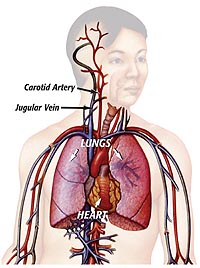Highlights
Reprinted from “Logos” - Spring 2003 — vol. 21, no. 1
Ice smoothie gives heart attacks the 'big Chill,' may save lives

CORONARY ON ICE — Outside hospitals, heart-attack victims have a poor chance of survival. An Argonne-developed ice slurry may put patients "on ice" until they can be saved at the hospital.
The pioneering work of researchers at Argonne's Energy Technology Division (now Nuclear Engineering Division) and the University of Chicago's Emergency Resuscitation Center may soon decrease the devastating effects of these sudden attacks.
The team was recently awarded a five-year grant for nearly $4 million from the National Institutes of Health to expand the medical applications of ice slurry — a mixture of ice and salt water that may be injected into the lungs for rapid cooling to sustain the heart and brain cells after cardiac arrests.
Ice slurry is an equal mix of ultra-small (equivalent to the diameter of a human hair) ice particles and a salt water liquid carrier. Originally, ice slurry was developed in the mid-1980s for industrial applications, particularly to replace the chilled-water cooling systems in building complexes.
"The idea was to use ice slurries because they contain ice particles that have a very high cooling capacity," said Ken Kasza, a senior mechanical engineer at Argonne. "With slurries we can get five to seven times the cooling capacity as we can with the same amount of chilled water."
The plan was to store ice particles in water over night in a central plant and then pump it from the plant to the surrounding buildings the next day. Ice slurry as a building coolant would allow more cooling from existing chilled water distribution systems or smaller pipes, pumps and storage tanks in new installations.

INTERNAL COOLING – An ice slurry fills the lungs and, if necessary, the area surrounding the carotid arteries. The blood passing through these "heat exchangers" is rapidly cooled. Chest compressions send the cooled blood to the brain. (Click on photo to view a larger image.
After some experimentation, the scientists found that in order for the mixture to be highly fluid, the ice particles must be rounded and smooth so they can flow easily and slip by each other; the salt and thermal melting help smooth the ice.
Since the only industrial interest was a small-scale demonstration in Japan, researchers sought a new use for the ice slurry technology. The result was a collaboration with the University of Chicago.
Slurry synergy
In 1999, as the Argonne-university initiative began, Kasza and Roger Poeppel, director of the Energy Technology Division, worked with University of Chicago Hospitals collaborators Lance Becker and Terry Vanden Hoek to develop the Emergency Resuscitation Center (ERC). The center brings together engineers, physicians, biologists and chemists from the university and Argonne to meet medical challenges. Cardiac arrests are a primary focus of the center.
"In the United States alone," said Poeppel, "sudden cardiac arrests strike about 1,000 people a day, and the survival rate is at best 2 to 4 percent. If we can improve survival rate by just 1 percent, we will save the lives of 10 people every single day."
People who suffer cardiac arrests outside of the hospital have a lower recovery rate. Brain cells start dying rapidly 10 to 12 minutes after an arrest, because of the lack of blood flow to the brain. Beyond this time, the person cannot make a full recovery. Even if the heart can be restarted, the person is brain dead.
ERC researchers wanted to investigate brain cooling using ice slurry to improve recovery rate. When cells cool, their metabolism and their chemical processes slow dramatically.

RAPID COOLING – A combination of ice slurry and surface cooling lowers the brain's temperature much faster than surface cooling alone. (Click on photo to view a larger image.
"That slow-down process can be introduced by cooling cells 2 to 6 degrees Fahrenheit," Kasza said. "It doesn't take a whole lot."
The difficulty, though, is cooling the body during cardiac arrest when there is no blood flow. External body-cooling is slow. In 10 minutes, external cooling only reduces temperature by 0.54 degrees Fahrenheit - not enough to protect the cells from damage.
Fluid fix
Because external cooling is too slow, the team proposed injecting ice slurry into the body to induce rapid internal cooling. Because of its viscosity, the ice slurry could spread to cool a large portion of the body. The question became where and how would the ice slurry be injected?
The team reviewed various body sections before settling on the lungs. The lungs are an in-body heat exchanger, because almost all of the body's blood moves past the lungs at some time.
Researchers reasoned that by filling the lungs with the ice slurry and maintaining chest compressions, the blood supply to the brain would be chilled and would slow cell activity and death.
In animal tests conducted at the University of Chicago Animal Research Center, researchers have inserted into the air way 2 to 4 liters of slurry using an endotrachea tube that measures 2 to 3 centimeters in diameter. The tube reaches to where the left and right lungs branch off. The ice slurry fills the lungs and cools the surrounding blood.


GOOD AND BAD ICE — Smoother ice crystals (lower image) make better slurries because they resist clotting in the body.
Data collected by the Argonne-university team have shown that the ice slurry can cool the brain by 10.8 degrees Fahrenheit within 10 minutes. The brain remains chilled for an hour, which in real life would give doctors more time to revive the heart, normal blood flow and brain activity. This, hopefully, would reduce or stop brain damage.
"We are getting cool-down rates that are 20 to 30 times faster than any external cooling," Kasza said.
After the ice slurry has served its cooling purpose, it would be suctioned out of the endotrachea tube.
Kasza said if the ice slurry procedure is eventually approved, it will still be secondary to defibrillation. In a real scenario, medics would first use the electric defibrillator, but if the heart has no reaction, the medics would call a local hospital familiar with ice slurry procedures and begin immediate cool down.
Slurry someday
Researchers are studying other medical applications for ice slurry. They have proposed injecting slurry directly into the bloodstream from the femoral artery in the upper leg, and they have suggested injecting the substance beside the carotid artery in the neck. The stomach and carotid arteries are also good in-body heat exchangers that do not put the slurry in direct contact with the blood.
"We're pursuing these other techniques, because there's potential not only in cardiac arrest treatment but also in treating strokes and other medical problems," Kasza said.
But other challenges still remain for slurry and cardiac arrest treatment. For example, the equipment that would be installed on ambulances must be easy to use. Researchers need to find the optimal cooling level of ice slurry, the correct timing and protocols, the toxicity levels, and how much of the brain survives after ice slurry is used.
With the money from the grant, the researchers hope to answer these questions.
"We hope to see the medical application of slurry used by first responders as a common procedure in the next three to five year," Kasza said. "With this funding and support, we'll be able to answer the questions to get us to that point."
Related Multimedia
 Laparoscopic
Partial Nephrectomy with Ice Slurry as Coolant in the Porcine Model
Laparoscopic
Partial Nephrectomy with Ice Slurry as Coolant in the Porcine Model
This video depicts the usage of ice slurry cooling, using a porcine model, for protecting the kidney from ischemia damage during a partial nephrectomy. The video illustrates the ease of use, protective benefits and advantages of using slurry cooling over cold saline solution.
Read full story and watch video
 Computer
model of a kidney being cooled by ice slurry
Computer
model of a kidney being cooled by ice slurry
Computer model of a kidney being cooled by ice slurry (model created with ABAQUS code)
Watch video
[ More News ]
Last Modified: Wed, April 20, 2016 9:41 AM


